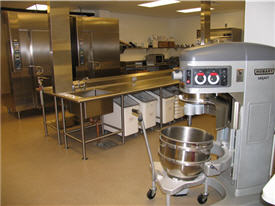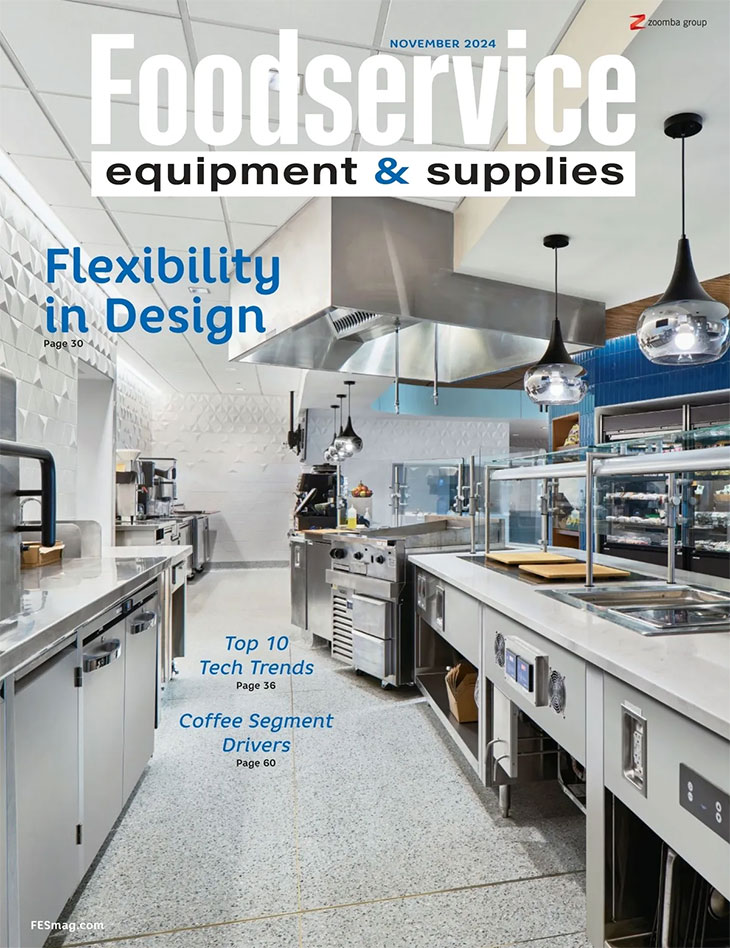This upscale continuing care retirement community's diverse foodservice program features bulk-cooking and blast-chilling capabilities and large preparation spaces that support a restaurant display kitchen, bistro and 23 other points of service.
NewBridge on the Charles, a senior housing and care facility serving the Boston area, opened June 2009 in Dedham, Mass. Owned by Roslindale, Mass.-based healthcare system Hebrew SeniorLife, the upscale, 162-acre continuing care retirement community (CCRC) occupies one-million square feet and houses nearly 270 residents.

Newbridge living accommodations include 50 cottages, 24 villa apartments, 182 regular apartments, 51 traditional assisted-living apartments, 40 memory-support rooms and a healthcare center housing both long-term-care and sub-acute patients. The campus is equipped with an array of programs to address the physical, emotional and spiritual dimensions of aging and foodservice is an integral part of the residents' experience. This fall, the site will provide services for 450 K-8 students in the Rashi School, a Jewish day school in Newton.
"We created spaces that connect to nature by using daylight, natural materials and colors found in nature," says Laurie Butler, the project's interior designer and senior associate at Perkins Eastman. "We wanted honest and simple yet elegant spaces, as well as a variety of dining venues that work well together."
"Acoustics are a large factor when designing for seniors," Butler adds. "We planned to use mostly carpet but wanted to vary the flooring type. We felt that wood created too much foot-traffic noise. The cork tiles give the warmth of wood but provide a surface that is a bit softer and quieter underfoot. The cork is sustainable and natural, meeting the design requirements."

"One of the initial design criteria was to maintain traditional Jewish kosher food options for the residents, as well as providing Jewish-style food options for people not committed to kosher eating habits," says Martin Siefering, a principal at Perkins Eastman which collaborated with Chan Krieger Sieniewicz on the architecture.
The campus includes kosher and non-kosher kitchens. Another requirement was that foodservice operations be shared by residents, visitors and staff in order to help build relationships between them, as well as providing an upscale environment. "The next generation of consumers is especially sensitive to compromising their existing lifestyle, and the design team ensured that the dining experiences at NewBridge on the Charles echo those of the local cafes and restaurants that the seniors currently enjoy," Siefering says.
In the dining areas, carpet tiles with recycled backing and recycled content in the face yarn allow for easy maintenance. "The slate floor surrounding the bistro is similar in color to the blue stone used on the patios both to the north and south, so the floor flows from interior to exterior, reinforcing the connection between the two," Butler says.
Indirect lighting is predominantly used. "We strive to create enough extra light for the senior eye without creating the glare that is especially distracting to that population."
In the main kitchen, staff bulk-prepare and blast-chill menu items that are delivered to 13 kitchens that serve the nursing/rehab areas and two kitchens accommodating assisted-living/dementia patients. At these units, steam-table pans and refrigerated shelves display the food, giving residents an opportunity to make selections. Separate kosher kitchens for meat and dairy, located adjacent to NewBridge's bistro concept, Nosh, serve other residents requesting kosher food.
Main-kitchen staff also prep and distribute menu items to Centro, NewBridge's display-style restaurant; Nosh; Treats, retail store and coffee shop, and for catering events.

"The next generation of consumers is especially sensitive to compromising their existing lifestyle, and the design team ensured that the dining experiences at NewBridge on the Charles echo those of the local cafés and restaurants that the seniors currently enjoy," Siefering says. Independent-living residents pay a monthly foodservice fee, which they can apply with a declining balance, similar to a debit account, at any of NewBridge's retail-style facilities.
If residents, staff and visitors select Centro restaurant, diners can begin in its club room/bar. Here and in Centro's informal and formal dining rooms, guests can watch chefs prepare menu items at its display-style kitchen, which Butler says provides a "dynamic dimension" to the dining environment.
Centro's display kitchen contains a refrigerator and a combi oven that cooks salmon, haddock, rotisserie chicken and pizza, according to Michael Spector, NewBridge's food and beverage director. The kitchen also includes a char broiler, range for heating sauces served over shell fish and linguine, double-tiered shelving and a full exhaust hood. A receptor pantry behind the display kitchen holds mise en place prepared in the main kitchen. Other dishes served at Centro include Portuguese mixed grill, herb-crusted cod, filet mignon, vegetarian options, salads and sides.
"Technology is in place so when guests order, their requests pop up on screens in the appropriate hot- or cold-prep areas," says Mike Taylor, the project's foodservice consultant and principal of Food Facilities Concepts, Inc.
Nosh is located within NewBridge's community center. Parents and students who attend the nearby Rashi School will also gather here for breakfast and lunch, selecting from soups, salads, sandwiches and beverages. "The space incorporates elements from the natural environment with slate flooring, wood detailing and floor-to-ceiling windows, all of which all open to a beautiful courtyard with outside seating," Butler says. Seating ranges from tabletops of four to couches.
In the main kitchen, product flows in a traditional progression from receiving to storage to preparation to cooking and holding and finally to distribution. "We designed the kitchen to provide varying levels of support for each facet of the entire operation, including everything from the restaurants to the country kitchen dining facilities," Taylor says.
Dry-storage areas accommodate paper, chemicals and ambient food. Cold storage includes walk-in produce, meat and dairy coolers and a walk-in freezer. "All areas all sized to accommodate the large variety and volume of food and beverage products," Taylor says.
A large preparation area supports both hot and cold food prep. Styles of preparation include both cook-serve and blast-cook-chilling.

Cook-serve is the primary focus, Taylor says. A large island-cooking area includes kettles for soups and sauces, a braising pan for stews, chili and meats, ranges for searing and sautéing, fryers and a grill for salmon, chicken and beef. Convection ovens handle baked goods; double-stacked combi-ovens and two roll-in combi-ovens braise brisket and roast pastrami, prime rib and turkey breast. "No doubt the combis are the most versatile equipment we have," says Michael Spector, NewBridge's food and beverage director.


Opposite the combi-ovens is the hot-food production equipment, which includes kettles, a tilt skillet and ranges with broiler tops and ovens beneath. The entire battery uses a single island-style ventilator with a utility distribution system (UDS) built with the hood. Kettles are fixed to the floor; but ranges are mobile so staff can easily clean the floors in this area. "The placement of the UDS also facilitates easy cleaning of the cooking areas and doesn't restrict views through the kitchen," Taylor says.
Two roll-in blast-chill units provide quick cooling for products. The kitchen also contains heated roll-in cabinets.
"The coolers, combis and heated cabinets all utilize the same mobile racks, so prepared products can go from storage in a walk-in cooler to cooking in a combination oven steamer to blast chilling in the roll-in blast chillers to hot holding without being handled," Taylor says. "This improves food safety and protects the high quality food."
All products produced in the kitchen are loaded into various types of transport carts for distribution to 25 final preparation and plating areas, such as food service pantries, nourishment areas and finishing kitchens located adjacent to points of service. A designated elevator allows staff to transport products to the floors for distribution.
The kitchen's pot-washing station with powered wash tank accommodates pans from 25 locations, and open areas receive the high volume of carts from various service points. A conveyor dishmachine for small pans operates in the middle of the room. Serviceware is washed at units located at each service point. "Very few facilities have this much transport taking place with so many pans coming into one space to be processed," Taylor says.
"The large staging area we have for clean carts is very important," Spector says. "Most designers don't think about that space, which is very important given our volume."

As NewBridge's resident population grows, Spector is confident that the staging area, as well as the equipment, will handle increased demand. "We're set up to expand easily to 750 residents," he says.
NewBridge on the Charles is a continuing care retirement community (CCRC) owned by Hebrew SeniorLife. Opened in June 2009, the facility includes independent, assisted-living and nursing-home facilities and foodservices, as well as a K-8 school. Today, 250 residents live in the community; future population is projected to be 750. The one-million-square-foot complex includes a 6,799-square-foot main kitchen with centralized food storage; Centro, a 2,900-square-foot restaurant and bar with open display kitchen and 2,453-square-foot dining area with 55 formal-dining-room seats and 110 casual-dining seats (the area also contains a 7-seat counter and 10-seat private-dining room); Nosh, a 2,476-square-foot bistro concept serving kosher meat products and a 1,372-square-foot dining room with 60 seats; a 500-square-foot store serving kosher dairy products and baked goods; Treats, a 200-square-foot ice cream/coffee shop with 6 seats; 13 country kitchen-style nourishment areas occupying 7,731 square feet in nursing home dining areas, with a total of 306 seats; 2 kosher country kitchen-style nourishment areas in 1,189 square feet serving nursing resident dining areas with a 32 seats; 1 321-square-foot foodservice pantry serving a nursing rehabilitation wing; two 1,200-square-feet country kitchen-style nourishment areas serving assisted living dementia resident dining areas with a total of 50 seats; a 1,147-square-foot kitchen serving assisted living residents in a 50-seat dining area and 10-seat private dining area; a 715-square-foot support pantry for a 4,600-square-foot multi-purpose conference area with 265 seats.
The total annual food and beverage budget is $6.4 million. Centro's average check for lunch, $10; dinner, $19; Sunday brunch, $23.50. Centro's average daily transactions: 250. Operating hours are lunch, 11 a.m. – 1:30 p.m., Monday through Saturday; dinner, 4 p.m. – 8 p.m., Monday though Saturday; and Sunday brunch, 11 a.m. – 6 p.m. Nosh's average check: $5. Nosh's average daily transactions: 300. Operating hours are 8 a.m. – 6 p.m. A total of 950 meals per day are currently served throughout the CCRC. The facility can handle 1,300 meals per day.




